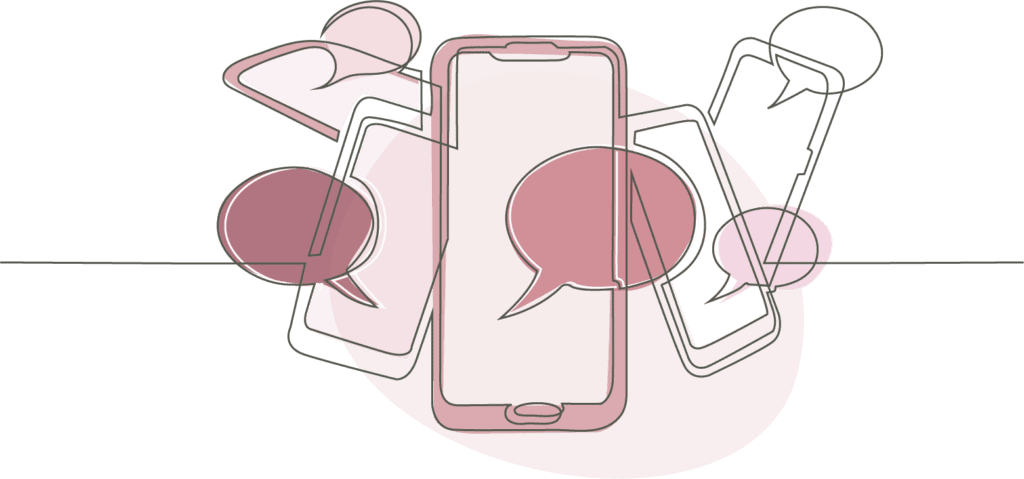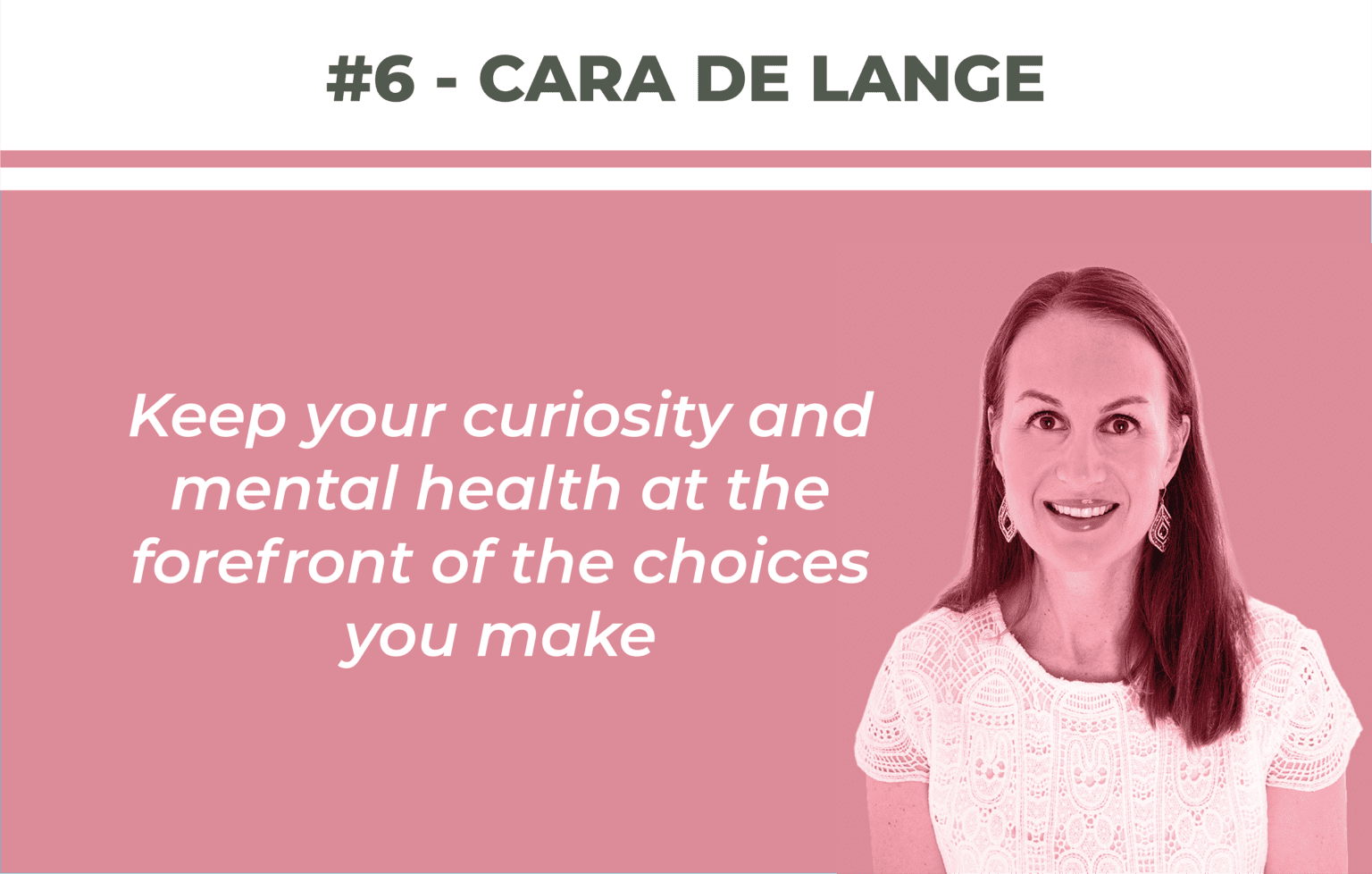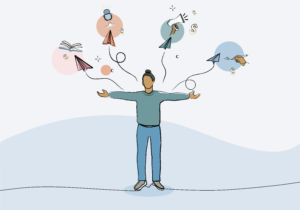Lexi Radcliffe-Hart
With career foundations in business administration for global organisations, including Google, Cara has taken her mental health advocacy to the next level, continuing her portfolio career as a wellbeing and business consultant, founder, author, and changemaker.
Reflecting on the burnouts we can experience both in “traditional” and portfolio careers, Lexi caught up with Cara on our podcast series PortfolioCast to discuss the benefits of controlling your own schedule, the ways we define success and approaches to boosting your mental health in lockdown.
Q: You’ve taken the skills that you’ve learned along, what many would see as, a traditional career path within business administration, to the pivot yourself as a mental health advocate and expert in your portfolio career. What prompted you to move towards this new career path?
A: I’ve always been interested in what gets people stressed, and what’s the psychology behind it and why we are goal focused and that goal is “busy, busy, busy and rush, rush, rush”.
It wasn’t really until I went through a burnout myself, quite a few years ago now, that it completely changed my life, and my outlook on life. And I just got even more curious.
Not only had I gone through this thing, I started to look around, and I saw other people as well. So this led me to research. And that actually then also led me to write my book, Softer Success, which is helping people prevent burnout, find balance and redefine their success. And I think, really, what came from that is the understanding that I just so passionately cared about other people not going through the same thing that I had gone through. And burnout, it can absolutely be prevented.
Now I work with thousands of people and help them prevent it. But burnouts can have a long build up, and we don’t always see it coming. And that’s really where I like to help people and say, “Look, this is what can happen, these are the things to look out for.” And you know, looking after our mental health is just as important as looking after our physical health.
So suddenly, with that came other things. I found myself on this portfolio career path that sort of came by accident really. The burnout happened, I started writing the book that then led me to set up my business in wellbeing consultancy and then other things have come. I started writing children’s books and children’s stories all about kindness and mental health. It’s all sort of pivoting in different areas. I guess the fact that I went through a horrible burnout was my main catalyst for completely changing things and wanting to help people live a more peaceful, balanced life.
Of course, I had to peel off all these onion layers to understand – really go into my perfectionistic self to understand how I got there, and what I needed to do to change. And that was not easy, because you’ll face up to some facts: that the way that you are, may not have been the right way.
By then I’d had some kids as well, and I wanted to show them a good example but I guess I was trying to do everything too well, you know, that’s why we try, and strive, and then this burnout happened.
But it’s about going into all of those layers, and then facing your fears. Right? I was really fearful of discovering what I could find there, but also about what I wanted to do to help people.
Like I was super afraid of standing up and talking in front of people. In the beginning, I was almost a bit embarrassed about sharing my experience. And then in the end, I ended up writing, now it’s in blogs etc. And it’s almost the more that I shared what had happened, and I could see how it was also helping people, the easier it got, if that makes sense? This is facing your fears, your biggest fears, turning them into a success really.
Q: With regards to portfolio careers, there’s always an element where you do have to face your fears. You have to own your story, understand your story, who you are and what you want to be – and owning that and showing all of yourself means there is a level of vulnerability that comes with having a portfolio career because you’re not carrying on down a perhaps more “normal” route that is often seen, or a kind of a perfect way of working?
A: Absolutely. I think it may become the norm, that portfolio careers I think are probably heading towards the norm. And actually, I also think that it was very easy for me to maybe continue in a corporate world and life. But inside, I felt I was different.
There was just this feeling coming out of wanting to help others and I needed to act on it. But it’s taking a leap of faith, right, and the balance as well, the portfolio career, you know, you did different things and challenges that come with it. So far, I love it.
Q: How have you found and gone about balancing your portfolio career, your family life, your mental health?
A: So obviously, I had to learn from absolute scratch because I wasn’t looking after myself, before I had the burnout. Or rather I thought I was, let’s put it that way.
That’s why I come in and talk to lots of people saying, well, you may think that you’re doing all the right things and ticking the right boxes. But sometimes, there are other things we need to do in order to prevent burnout.

The way that I balance it is, I make sure that I’m running on my own schedule. So even though I’m in a portfolio career, even when I was post-my burnout and back in the office, it’s very easy to get caught up against other people or stakeholders, clients, and deadlines. But making sure that my own schedule is 100% clear is important. There are three ways that I do that.
First of all, I always have a dedicated start and finish time. At the end of the day, I finish when I close down my laptop and I’ve checked my schedule and made sure that for the next day, I’ve got moments of joy planned in and a moment to connect to myself in the middle of the day.
Then, when that is done, I ask myself four questions.
- What did I do really well, today?
- What did not go that well?
- What have I learnt?
- And who inspired me?
This takes about two minutes.
Then just before I go to bed, and this is when our subconscious mind starts working on this, I set a – it’s like a bit of gratitude combined with a positive affirmation – so I’m always saying something like, “I’m so grateful for the day that I’ve had any challenges that I’ve faced, I’ve handled effectively. And tomorrow I’m looking forward to a peaceful, joyful and balanced day” or “I will be peaceful, joyful and balanced”. This is then already programmed in my brain, so the moment that I wake up, I reiterate that and again, I have a few minutes of thinking about the things that I’m grateful for.
I also always take time in the middle of the day to just recalibrate and connect to myself. To get out of the head, back into the body in whatever way. That could be meditation, I could go out for a bike ride. I could simply, if I’m busy, just feel my palms and feel my toes and wriggle my toes. It could be something short, but there’s always a moment that I take time to reconnect to myself. And I guess those things help me stay balanced and in control of my own schedule.
Q: Lockdown, especially for those of us who don’t work regularly within teams, could be facing a lot of loneliness right now. What few things would you recommend to those people in this position?
A: We have to look at how you are as a person, right? Some people are extroverted and need to be with other people in order to function, and others are introverted, and the introverts have probably enjoyed more the lockdown and being able to work from home.
Either way, loneliness is really horrible. But what I like to use is the HALT method. So it’s basically taking a moment to stop during your day, and asking yourself, “what do I really need right now?” And then HALT stands for hungry, angry, lonely or tired.
So are the feelings that are coming up because you’ve been working hard and you’ve not had enough to eat or to drink? Are you lonely? Do you need to call somebody? Do you need to process something if you’re angry? Or are you tired? Do you simply need to rest more?
And I just want to share with you a little story about loneliness that may help people as well. The Mount Sinai Hospital in New York did some research on Prisoners of War from the Vietnam War. And they’ve been Prisoners of War and they’d been kept in these tiny prison cells for years. And these guys actually came out quite resilient. Mount Sinai Hospital was curious to find out why.
So firstly, they made connections. You’ll think, how could they’ve made connections? They couldn’t talk. They couldn’t see each other. They were in cells on their own. But guess what? They developed a tapping mechanism. So a little mechanism of communicating with each other somehow on the walls. And this helped them. So connections are really, really important.
Then what they also did is they accepted where they were. They had to accept it, but they also had this realistic optimism.
So that’s not your kind of, “everything’s gonna be okay”, optimism, but more like, “this is the situation we’re in”. So acceptance: “this is what we’re doing about it, we’ve developed this tapping mechanism to make connections to stay in touch, and we’re helping each other through, and we’re gonna get through this.”
So I guess my message here on loneliness is, we still are able to communicate with each other. And we may not be able to see people to give them hugs, but if these guys can do it, and this the study on ways of building resilience shows it, so we can totally do it by just picking up the phone more often, and staying in touch with our friends and family and our nearest and dearest. And thank goodness, we do have Zoom, we have WhatsApp, we have all ways to stay in touch, and also know that this is not going to be forever.
Q: What would be your top tip for avoiding burnout whilst our home and work life boundaries are blurred?
A: The biggest thing I can say is, please set boundaries around technology. Our smartphones are great, our technology is great. But our minds are being bombarded with information all the time. If it’s not work, it’s news. It’s media, it’s social media. And we need a break from that. Because what’s happening is it’s affecting our concentration. I see this time and time with clients.

So I guess the biggest tip is, make sure you do a real recharge and not a fake recharge, really make sure that you’re recharging. So, put the phone away unless you’re using it for meditation or something but then put it away and go and do something else that really recharges you.
Listen to the whole conversation on Episode 6 of PorfolioCast:
Think this sounds like the right path for you? Come along to our monthly Community Welcome Call for new members to find out what a portfolio career could look like and how The Portfolio Collective can help you take those first steps towards professional success – and don’t forget to connect with our community!




2 responses to “Portfolio Journey Series: Cara de Lange”
I loved doing this podcast with you, thank you Lexi and TPC!
I loved it too – excellent to seeing it help so many.